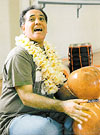By Vicki Viotti
Advertiser Staff Writer
 |
| Kumu hula Keaulana returns to the formality of a hula program in his demonstration.
Gregory Yamamoto • The Honolulu Advertiser
'A Celebration of Hawaiian Poetry in the Hula'
Kimo Keaulana
7 p.m. tomorrow
Halau o Haumea, Center for Hawaiian Studies
Free |
Kimo Keaulana and his halau will present a formal hula program in which the chants, dances and choreography performed will be those that were passed down from previous generations.
There’s poetry in hula, even in the way it’s performed.
In these days of hula competitions, where the next dance is whatever’s listed in the program, we’ve forgotten that hula once followed a protocol, said Kimo Alama Keaulana, a kumu hula determined to refresh the collective memory.
"We don’t see hula in a formal program anymore," said Keaulana, a Hawaiian language instructor at Honolulu Community College whose halau, Lei Hulu Hula School, is readying a revival of sorts for tomorrow (see box).
Hawai‘i has seen little of this formality since the 1950s or ’60s, he said, since the presentations of scholar Mary Kawena Puku‘i, her daughter Pele Puku‘i Suganuma, chanter Ka‘upena Wong and famed dancer ‘Iolani Luahine.
"Generally, when you’re putting together a formal program like this, you are going to honor gods and goddesses first," he added. "Then you come down to the chiefs. Then you dance the other dances for the common folk."
Lest it all be forgotten, Keaulana is giving a lecture, "A Celebration of Hawaiian Poetry in the Hula," followed by a demonstration of that protocol by his dancers. The event is sponsored by the Hawai‘i Literary Arts Council, with support from the HCC language arts department, the University of Hawai‘i Center for Hawaiian Studies and the Committee for the Preservation and Study of Hawaiian Language, Art and Culture.
"All chants, dances, drumming patterns and choreography will be those that were actually passed from one generation to another - intact," he said. "I had promised never to intentionally change any aspect of what was handed down to me, and so this is what will be presented, pure, unadulterated hula in its pristine preservation."
Keaulana, 46, studied the long-est under Adeline Maunupau Lee, who in turn was a student of the hula and chant master Joseph Ilalaole.
The demonstration will include a discussion of some of the symbolism and poetic devices of chant.
"Hawaiians did not have rhyme," he said. "Rhyme is a Western device. Hawaiians did have what is called linked assonance - when we have couplets in poetry, the last word in the couplet will have a sound-alike in the line following it."
Examples include these lines from a hula dedicated to Queen Emma. One couplet:
Aia e ka nani i Puaka‘ilima
Kela ‘ailana noho i ke kai
(There is beauty in Puaka‘ilima
That island that nestles in the sea)
No kai ka makani la a he Kona
Ha‘iha‘i lau la‘au o ka uka . . .
(From the sea comes the Kona wind
Tearing the leaves from the trees from the upland...)
The word "kai" ending the first couplet reappears in "no kai ka makani."
As for symbolism, it applies to so much in chant that it’s hard to know where to start. Keaulana’s students will perform a hula from the repertoire of chants about the fire goddess Pele, her lover Lohi‘au and her sister Hi‘iaka. Encounters among these three are fraught with drama, he said, because of Pele’s explosive temper. Place names might actually be a symbol for an emotional aspect.
"One of the numbers we’re going to be doing is called ‘Pu‘uonioni,’ which means ‘trembling hill,’" he said. "Pele wants one of her sisters to get Lohi‘au. Hi‘iaka feels obligated to go, but she knows how Pele is. In her mind, she’s ‘at Pu‘uonioni’ because she’s unstable in her thinking (about the journey)."
There always more to hula than meets the eye or ear.
"Hula is rampant all over the world now, but people now equate hula with competition, as was not the case in old Hawai‘i," Keaulana said. "What we will be doing is to explain the poetry of the poetry, and how it all fits into the scheme of things in a formal presentation of Hawaiian dance."
[back to top] |

 The Great Index to Fun
The Great Index to Fun